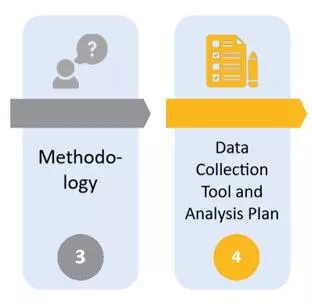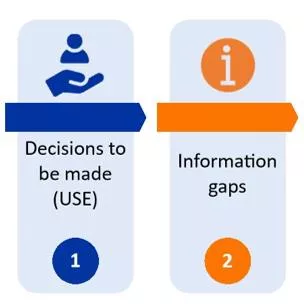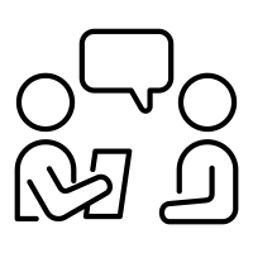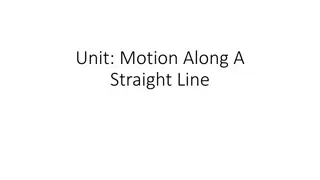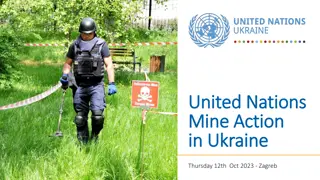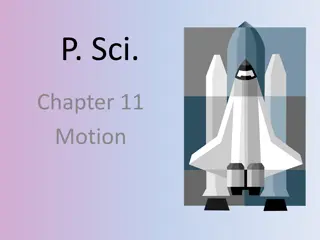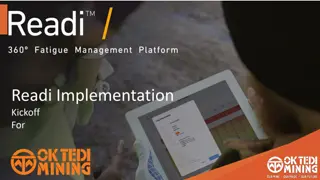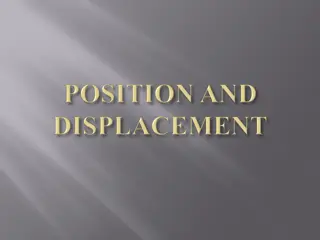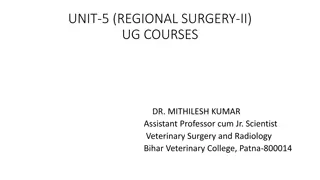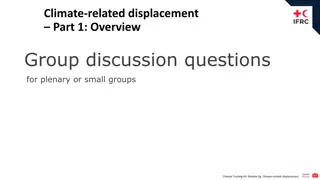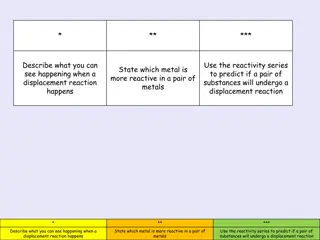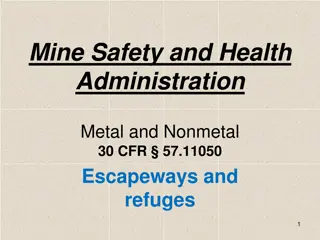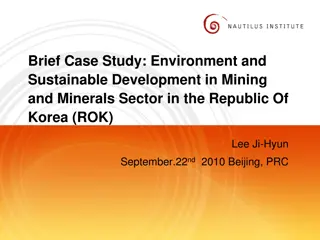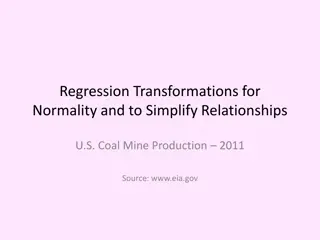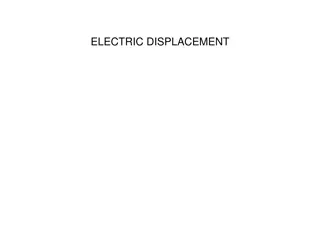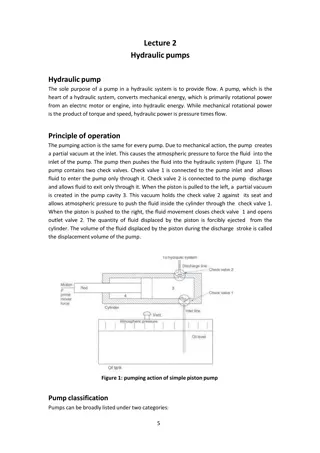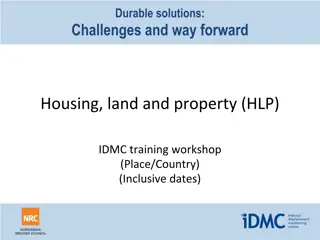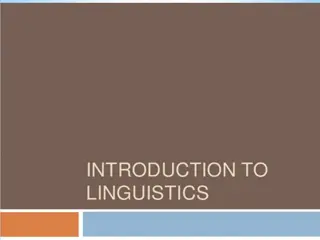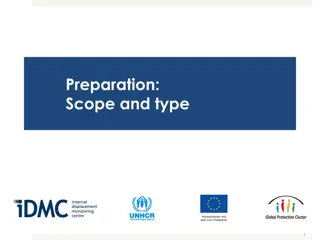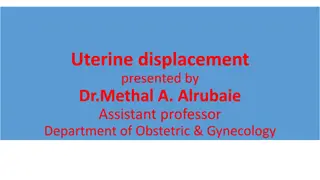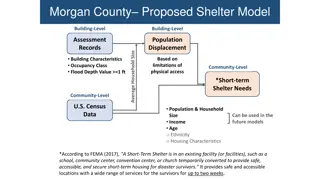DISPLACEMENT DATA AND MINE ACTION
Overview of collaborative efforts between UNMAS, IOM DTM, and local communities in Ethiopia, Mali, Nigeria, and the DRC to address explosive ordnance contamination, prioritize locations for risk education, and enhance mine action through data collection, awareness-raising, and information sharing.
Download Presentation

Please find below an Image/Link to download the presentation.
The content on the website is provided AS IS for your information and personal use only. It may not be sold, licensed, or shared on other websites without obtaining consent from the author. Download presentation by click this link. If you encounter any issues during the download, it is possible that the publisher has removed the file from their server.
E N D
Presentation Transcript
DISPLACEMENT DATA AND MINE ACTION EXAMPLES OF COLLABORATION IN ETHIOPIA, MALI, NIGERIA AND THE DRC Prepared by UNMAS Geneva Office and IOM DTM, March 2024
Ethiopia: Advocacy for Mine Action DTM helped UNMAS to obtain data on contamination in northern Ethiopia UNMAS identified information needs: IDPs perceptions of Explosive Ordnance contamination in their communities. DTM and UNMAS used the Field Companion for Mine Action to select 3 questions to address information gaps through non- specialist key informants. UNMAS and DTM adjusted the questions to the context DTM collected and shared information with UNMAS UNMAS used it to better understand the situation in Tigray and to make the case for the activation of the Mine Action AoR.
Ethiopia: Questions Incorporated in the DTM Information Questions Answer options Source/User 1. Yes, we know that there are explosive ordnance in this location or next to it. However, they are not marked by any sign; 2. Yes, we know that there are explosive ordnance in this location or next to it. However they are marked by signs; 3. No, based on what we know, there are no explosive ordnance in this location or next to it; 4. we do not know/no answer. Locations where key informants reported presence of EO. Are there explosive ordnance in this location or next to this site? DTM Field Companion Questionnaire Is the presence of explosive ordnance making it difficult for people to earn a living? (e.g., there are explosive ordnance in the agricultural fields, there are explosive ordnance where the livestock would graze, there are explosive ordnance on the way to selling items...) Locations where communities have reported reduced access to land, resources or livelihood due to EO contamination. 1. Yes, for many people; 2. yes, for some people; 3. No; 4. Do not know/no answer. (Optional answer: 1. Nobody (around 0%); 2. A few (around 25%); 3. About half (around 50%); 4. Most (around 75%); 5. Everyone (around 100%); 6. Do not know /no answer.) DTM Field Companion Questionnaire Have you observed/are you aware of any civilians in your community who have been injured or killed by explosive hazards? Locations where communities report casualties DTM Field Companion Questionnaire 1. Yes; 2. No; 3. No response; 4. Don't know.
Nigeria: Triangulation to Maximize Resources MA AoR DTM and IMSMA data to prioritise locations for explosive ordnance risk education MA AoR analysed DTM data together with data from other sources to prioritize communities for EORE activities. MA AoR enhanced the HRP prioritization system, incorporating additional criteria sourced from the DTM data DTM and Mine Action Partners developed questions that could be used to obtain the identified information through non-specialist key informants. MA AoR raised awareness of Explosive Ordnance risks among DTM enumerators. MA AoR partners in Nigeria identified information needs: locations where communities had witnessed explosions and communities that had not received Explosive Ordnance Risk Education (EORE) DTM collected and shared information with the MA AoR on a regular basis
Nigeria: Explosive Ordnance Incidents in 2023 Local Government Areas (LGAs) where respondents reported to have heard explosions of explosive weapons in less than six months within Borno, Adamawa and Yobe (BAY) states. According to respondents, EO accidents happened mostly to farmers, followed by men, IDPs/returnees, boys, women, wood collectors, and drivers while they were working on their farms, collecting firewood, moving from one place to another, and collecting scrap metals.
Nigeria: Analysis of Explosive Ordnance Risk Education in 2023 HRP Local Government Areas where respondents stated that the community received EORE sessions in the past year, within BAY states. Respondents who received EORE EORE safety messages were from billboards, face-to-face, Nigerian security forces, radio, parents, family members and friends.
Explosive Ordnance Risk Education Sessions in Nigeria @ UNMAS
Mali: Understanding and Protecting IDPs Perception and impact of EO on communities in Location of Displacement and Location of Origin UNMAS in Mali identified information needs: perception of the presence of EO by communities and impact on their life, both in location of displacement and location of origin DTM and UNMAS used the DTM Field Companion on Mine Action to develop questions that could be used to obtain the information through non- specialist key informants. DTM collected and shared information with UNMAS on a regular basis UNMAS used the information for prioritization of EORE efforts DTM also enhanced the coordination between mine action and other actors in displacement sites.
DRC: Locating Explosive Ordnance Risk Information on perception of EO contamination and on accidents for Operational Planning UNMAS in DRC identified information needs: perception of the presence of EO by communities and EO incidents impacting people DTM and UNMAS used the DTM Field Companion to identify 4 questions that could be used to obtain this information through non- specialist key informants UNMAS DRC trained 335 IOM enumerators (25% women) DTM collected and shared two sets of data with UNMAS: 1) analysis of the aggregated dataset, and 2) village-specific dataset with additional geocoordinates UNMAS used the information for evidence-based advocacy, resource mobilization, and operational planning, adhering to the confidentiality requirements defined in the Data Sharing Request.







